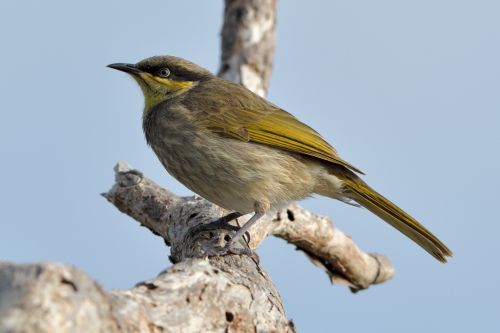Sbarnhardt (talk | contribs) (Edited username Mzungu to Ken Doy x 1 & image pixel to 500px) |
|||
| (One intermediate revision by one other user not shown) | |||
| Line 1: | Line 1: | ||
| − | + | [[Image:Mangrove Honeyeater 00000001.jpg|thumb|500px|right|Photo by {{user|Ken+Doy|Ken Doy}}<br />King Island, Wellington Point, Brisbane, [[Queensland]], [[Australia]], August 2017]] | |
| − | [[Image: | ||
;[[:Category:Gavicalis|Gavicalis]] fasciogularis | ;[[:Category:Gavicalis|Gavicalis]] fasciogularis | ||
''Lichenostomus fasciogularis'' | ''Lichenostomus fasciogularis'' | ||
==Identification== | ==Identification== | ||
| − | + | 19·5 cm (7¾ in) | |
| + | *Olive-brown upperparts | ||
| + | *Greyish-brown rump and uppertail [[Topography#General Anatomy|coverts]] | ||
| + | *Yellow edges to wing and tail feathers | ||
| + | *Yellowish-brown throat | ||
| + | *Broad black band through the eye, bordered below by a yellow streak | ||
==Distribution== | ==Distribution== | ||
| − | [[Australia]] | + | Found in coastal eastern [[Australia]] (central [[Queensland]] to Hastings River, [[New South Wales]]) |
| + | |||
==Taxonomy== | ==Taxonomy== | ||
| − | This is a [[Dictionary_M-O#M|monotypic]] species.<br /> | + | This is a [[Dictionary_M-O#M|monotypic]] species<sup>[[#References|[1]]]</sup>.<br /> |
| + | |||
Formerly placed in the genus ''[[:Category:Lichenostomus|Lichenostomus]]''. | Formerly placed in the genus ''[[:Category:Lichenostomus|Lichenostomus]]''. | ||
==Habitat== | ==Habitat== | ||
| − | + | Most found in mangrove forests and other coastal woodlands in bays, estuaries and on islands. | |
==Behaviour== | ==Behaviour== | ||
| + | ====Diet==== | ||
| + | Their diet consists mostly of nectar and invertebrates (such as insects, marine snails and crabs), also possibly fruit. | ||
| + | ====Breeding==== | ||
| + | They construct a cup-shaped nest from dried grass, sea grass and other plant fibres. | ||
| + | ==References== | ||
| + | #{{Ref-Clements6thAug17}}#Handbook of the Birds of the World Alive (retrieved August 2017) | ||
| + | {{ref}} | ||
==External Links== | ==External Links== | ||
{{GSearch|Honeyeater+fasciogularis}} | {{GSearch|Honeyeater+fasciogularis}} | ||
[[Category:Birds]] [[Category:Gavicalis]] | [[Category:Birds]] [[Category:Gavicalis]] | ||
Latest revision as of 15:19, 8 December 2020
- Gavicalis fasciogularis
Lichenostomus fasciogularis
Identification
19·5 cm (7¾ in)
- Olive-brown upperparts
- Greyish-brown rump and uppertail coverts
- Yellow edges to wing and tail feathers
- Yellowish-brown throat
- Broad black band through the eye, bordered below by a yellow streak
Distribution
Found in coastal eastern Australia (central Queensland to Hastings River, New South Wales)
Taxonomy
This is a monotypic species[1].
Formerly placed in the genus Lichenostomus.
Habitat
Most found in mangrove forests and other coastal woodlands in bays, estuaries and on islands.
Behaviour
Diet
Their diet consists mostly of nectar and invertebrates (such as insects, marine snails and crabs), also possibly fruit.
Breeding
They construct a cup-shaped nest from dried grass, sea grass and other plant fibres.
References
- Clements, J. F., T. S. Schulenberg, M. J. Iliff, D. Roberson, T. A. Fredericks, B. L. Sullivan, and C. L. Wood. 2017. The eBird/Clements checklist of birds of the world: v2017, with updates to August 2017. Downloaded from http://www.birds.cornell.edu/clementschecklist/download/
- Handbook of the Birds of the World Alive (retrieved August 2017)
Recommended Citation
- BirdForum Opus contributors. (2024) Mangrove Honeyeater. In: BirdForum, the forum for wild birds and birding. Retrieved 10 May 2024 from https://www.birdforum.net/opus/Mangrove_Honeyeater




